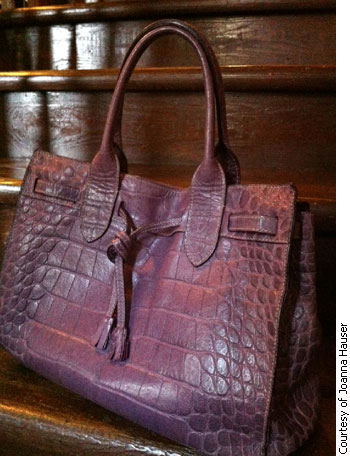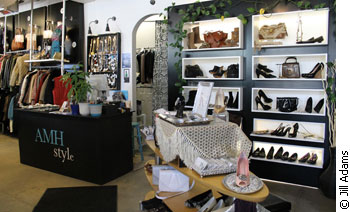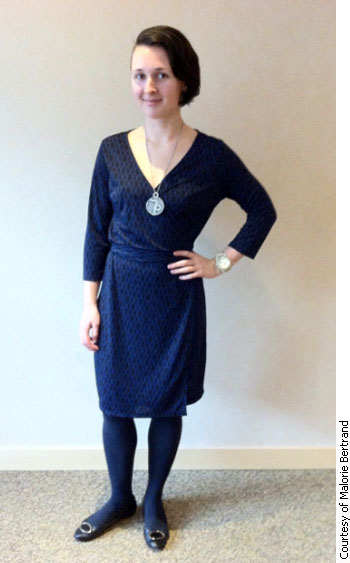Tags
Related Posts
Share This
Consignment shopping’s new lease on life
If money weren’t an issue, I wouldn’t stop consignment shopping; I would just buy more. This isn’t a remix of Barenaked Ladies’ “If I Had a Million Dollars,” but the gist of Joanna Hauser’s sentiments on clothes shopping. For Hauser and others in Ottawa, consignment shopping is about the adventures it entails, the unique chance at acquiring certain labels and styles, and giving new life to previously loved items, as well as about the savings.
Hauser, 42, works in marketing but finds time at least once a week to go to her favourite local consignment stores, including Bella in Bells Corners, My Sister’s Closet in Kanata and Ragtime Vintage Clothing downtown. She says she goes often because with consignment shopping you never know what you’re going to find, or when you’ll find it. Part of the appeal is the adventure.

Joanna Hause’s Dooney & Bourke purse, bought on consignment.
“It’s kind of fun to go in and find a really well loved bag, and you bring it home and you make it your own,” she says excitedly. Recently, she says, she came home with a well-worn purple, Italian leather, Dooney & Bourke purse from My Sister’s Closet for only $36.
Consignment stores offer styles and brands beyond what you would find at the Rideau Centre and other local malls. Hauser prefers consignment stores to mainstream ones because she finds things she likes more easily. Generally, most items are one of a kind, so Hauser figures she’s less likely to see someone else wearing the same shoes or shirt as her. “You’re not going to look like everybody else. ’Cause nobody wants to look like everybody else,” she admits through a laugh.
Malorie Bertrand, Editor-in-Chief of EF Magazine, an online sustainable-fashion publication, says, for her, the importance of consignment shopping is environmental more than monetary. Bertrand, 26, values the concept of recycling clothing and keeping as many items out of landfills as possible. But she also agrees about the adventure that these stores offer: “I enjoy the hunt of riffling through the racks and finding unique pieces and putting together outfits.” Bertrand’s favourite Ottawa consignment stores include Ricochet Resale on Richmond Road, Young Janes on Dalhousie Street and AMH Style on Wellington Street West.
AMH Style: part of a new wave

That boutique look: AMH Style in Ottawa specializes in high-end brand names and unique designer labels for women.
Alison Hughes, co-owner of AMH Style, agrees that many of her customers are looking for something different that not every Ottawa store is going to have. AMH Style carries a number of exclusive labels: “We get Jimmy Choo, Prada, Fendi,” Hughes says, explaining that she and her sister hand-pick all of their inventory. The selection mostly comprises brand names and designer labels that you can’t buy elsewhere nearby, she says, “brands that not even Holt Renfrew in Ottawa carries.” Hughes attributes this to the different brands that people buy when travelling or shopping online, that are reflected in the clothes they bring in to resell. As well, Hughes adds, other shoppers are drawn to consignment shopping because of the savings and, perhaps more commonly, the eco-friendly aspects of it.
AMH Style typifies a new breed of consignment stores, different from the traditional model, that are popping up in Ottawa to offer a shopping experience more similar to a high-end boutique. This includes preselected inventory, visually appealing displays and great customer service. The old consignment stigma is “stuffy, blah, used clothing, etc.,” says Hughes. It used to be that people shopped consignment because they had to, not because they wanted to.
Catching on in Ottawa
Consignment shopping is no longer something you try to hide; instead, it’s very popular.
But Hughes thinks people are starting to understand what consignment is now, versus what it used to be. She says consignment shopping is no longer something to try and hide from people; instead, it’s very popular. Over the last few years, there has been a rise of “new breed” consignment stores in the city. Among these are Bella Women’s Consignment Boutique, that opened nearly five years ago, Ricochet Resale, from just over a year later, 2009 and AMH Style which will celebrate its second anniversary in May. And this expansion has not been limited to the city; in recent years, Hughes has seen more consignment stores opening in the suburbs, for example in Barrhaven and Carleton Place, meaning that consignment is now more accessible than ever. In fact, the focus of consignment stores is also diversifying; unlike in the past, when the majority of regional consignment stores dealt in vintage pieces or bridal wear, there has been a rise in stores specializing in children’s clothing and high-end women’s clothing.
Along with the stores, Hughes says, she has also noticed a tremendous rise in the number of shoppers for second hand. Many in the city will actually head to a nearby consignment store before going to the mall, she explains. Bertrand agrees; in her opinion, consignment shopping is much more acceptable than it was even five years ago. “Now a lot of people say they don’t like to tell their friends about this store [AMH Style] because they’re afraid they will scoop everything up,” Hughes says, laughing. She adds that consignment shopping will only continue to grow in Ottawa as more people embrace it.
Who shops consignment?

Malorie Bertrand, in a whole outfit from consignment: The black leather Oscar de la Renta flats cost her $18.
Amid consignment shoppers’ rise, Bertrand has watched the trend become especially popular with younger generations: “What we consider to be the trendy youth of today, without stereotyping, prefer second hand.” For one, it’s cost effective and eco-friendly, and consignment shopper’s find themselves with a unique selection, different from the latest trends in stores. Many like the ability to create their own looks with unique pieces that help them stand out or by restyling old pieces in modern ways, rather than choosing from what’s laid out for them in a mainstream store. While young people may be driving this change, it is definitely not confined to youth. It embraces shoppers in their mid-to-late teens all the way up to anyone who’s “fashionable at heart,” as Hughes would say: “It’s more like a style state of mind – trendy, fashionable and stylish.” Nathan Armstrong, manager at Ragtime Vintage Clothing, would agree; he believes it’s not always about the cost of things, but the unique selection and styles that draws people to the store. “We get everyone from street kids to millionaires and everyone in between.”
But in some cases the stigma is not entirely gone; some shoppers are still turned off by the consignment idea, possibly relating to a cleanliness issue. “Especially shoes,” says Hauser who still has the occasional person raise an eyebrow when she tells them she shops consignment. “People seem to have a hard time with shoes, yet they walk around a gym change room in bare feet!” Others just don’t have the time and energy for the hunt, and prefer the convenience and large selection of mainstream.
Bertrand believes that consignment is the future. She says she tries to proselytize: Each time a friend compliments something of hers from a consignment, she jumps at the chance to tell them. She hopes that this will give them the idea to check out a consignment store when they otherwise wouldn’t have.
Says Hughes, “the more people who know about it, the better it is for everyone.”
A new breed of consignment
Can second hand “rejects” really be fashionable? Absolutely. Yet, for some shoppers, the thought of consignment still raises outdated stigmas. A cluttered store with racks of outdated clothing is what’s pictured by those who haven’t had the pleasure of shopping consignment recently. Some of the most common misconceptions include:
- Consignment stores lack organization, so it will be time consuming to find what you are looking for.
- The selection is mostly outdated and used pieces, so it will be difficult to find something fashionable.
- You won’t get compliments on clothes you bought second hand; they aren't clean or as nice as something new.
However, these stigmas have no merit. Today it’s hard to tell the difference between a consignment store and a high-end boutique: The new breed of consignment store is more mainstream in appearance, organization and selection. Generally it is more strict on what brands it accepts and the condition of the clothing, and more attention is paid to current trends during inventory selection; this way, brands and trends are more recognizable. The store will also have trendy merchandising displays and will sort clothing based on style or purpose, to cut down on the time it takes to find what you’re looking for. The new breed of store often observes time limits on how long it will keep an item in stock, to help ensure a clutter-free, shopper-friendly store.
In essence, the store has become more approachable: New shoppers are often pleasantly surprised.





